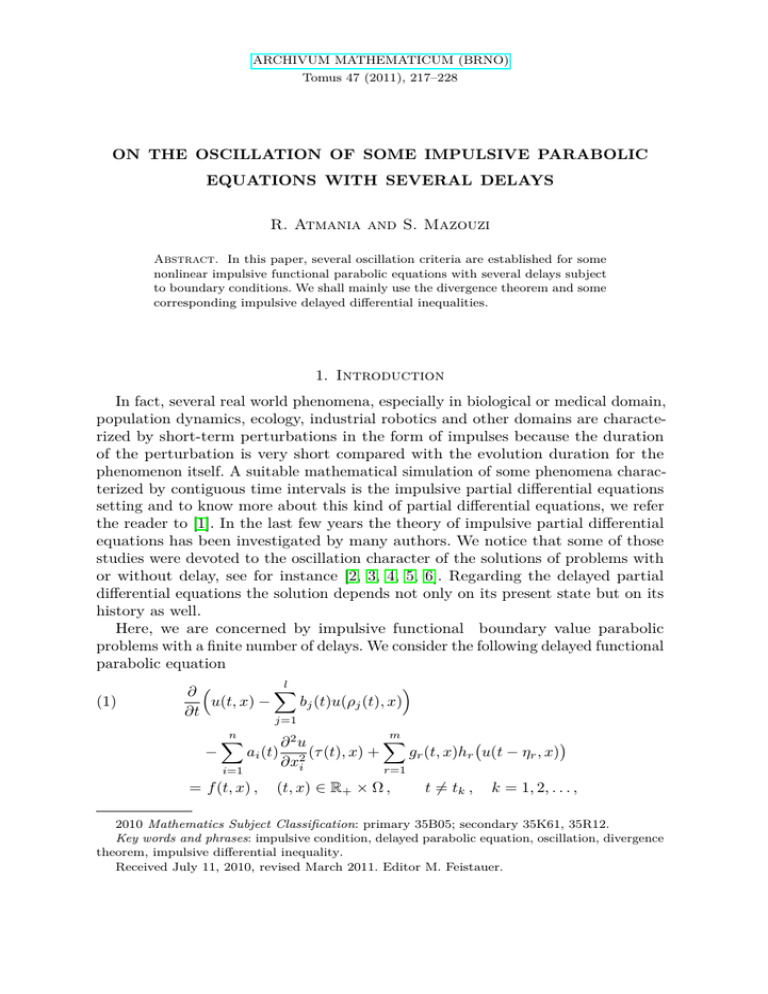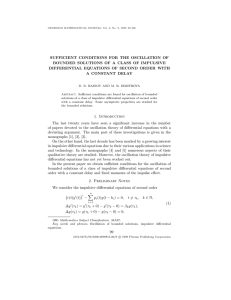ON THE OSCILLATION OF SOME IMPULSIVE PARABOLIC EQUATIONS WITH SEVERAL DELAYS
advertisement

ARCHIVUM MATHEMATICUM (BRNO)
Tomus 47 (2011), 217–228
ON THE OSCILLATION OF SOME IMPULSIVE PARABOLIC
EQUATIONS WITH SEVERAL DELAYS
R. Atmania and S. Mazouzi
Abstract. In this paper, several oscillation criteria are established for some
nonlinear impulsive functional parabolic equations with several delays subject
to boundary conditions. We shall mainly use the divergence theorem and some
corresponding impulsive delayed differential inequalities.
1. Introduction
In fact, several real world phenomena, especially in biological or medical domain,
population dynamics, ecology, industrial robotics and other domains are characterized by short-term perturbations in the form of impulses because the duration
of the perturbation is very short compared with the evolution duration for the
phenomenon itself. A suitable mathematical simulation of some phenomena characterized by contiguous time intervals is the impulsive partial differential equations
setting and to know more about this kind of partial differential equations, we refer
the reader to [1]. In the last few years the theory of impulsive partial differential
equations has been investigated by many authors. We notice that some of those
studies were devoted to the oscillation character of the solutions of problems with
or without delay, see for instance [2, 3, 4, 5, 6]. Regarding the delayed partial
differential equations the solution depends not only on its present state but on its
history as well.
Here, we are concerned by impulsive functional boundary value parabolic
problems with a finite number of delays. We consider the following delayed functional
parabolic equation
(1)
l
X
∂
u(t, x) −
bj (t)u(ρj (t), x)
∂t
j=1
−
n
X
ai (t)
i=1
= f (t, x) ,
m
X
∂2u
(τ
(t),
x)
+
gr (t, x)hr u(t − ηr , x)
2
∂xi
r=1
(t, x) ∈ R+ × Ω ,
t 6= tk ,
k = 1, 2, . . . ,
2010 Mathematics Subject Classification: primary 35B05; secondary 35K61, 35R12.
Key words and phrases: impulsive condition, delayed parabolic equation, oscillation, divergence
theorem, impulsive differential inequality.
Received July 11, 2010, revised March 2011. Editor M. Feistauer.
218
R. ATMANIA AND S. MAZOUZI
subject to the impulsive conditions
(2)
−
u(t+
k , x) − u(tk , x) = I tk , x, u(tk , x) ,
k = 1, 2 . . . ,
x ∈ Ω,
with the boundary condition
(3)
u(t, x) = ψ(t, x),
(t, x) ∈ R+ × ∂Ω ,
t 6= tk ,
k = 1, 2, . . . .
Inspired by the results of Fu et al. [4] where they considered an impulsive
parabolic system with delay where bj (t) = 0, j = 1, . . . , l, τ (t) = t, m = 1, f (t, x) =
0, we intend to extend some of those results and obtain some practical oscillation
criteria for the problem (1)–(3) subject to one of the two kinds of boundary
conditions used in [4] by using the divergence theorem and some appropriate
impulsive delayed differential inequalities based on the property of the first positive
eigenvalue and the corresponding positive eigenfunction of a Dirichlet problem.
Actually, the techniques that we are going to use in the sequel are applied by some
authors to obtain other oscillation criteria. For example, Bainov and Minchev [1]
treated such a problem under the assumptions bj (t) = 0, j = 1, . . . , l, τ (t) = t,
ai (t) = a(t), i = 1, . . . , n and m = 1, with two kinds of boundary conditions while
Cui et al. [3] investigated a similar problem under two kinds of boundary conditions
with bj (t) = 0, j = 1, . . . , l, the diffusion term has somehow a different form and
f (t, x, u) = −p(t, x)u(t, x). The results are obtained under different conditions on
the diffusion term, the delay arguments as well as on the impulses effect.
2. Preliminaries
In this section, we shall introduce the notations and the basic definitions which
will be used throughout the paper. We set the following assumptions:
(H1) Ω is a bounded domain with smooth boundary ∂Ω, t ∈ R+ = [0, +∞) and
the impulses times are such that 0 < t1 < t2 · · · < tk . . . ; limk→∞ tk = +∞,
(H2) ai ∈ C(R+ ; R+ ) with ai (t) ≥ a0 , i = 1, 2, . . . , n, for some positive constant
a0 ; τ ∈ PC(R+ ; R) with τ (t) ≤ t and limt→∞ τ (t) = +∞; bj ∈ PC 1 (R+ ; R+ ),
ρj ∈ PC 1 (R+ ; R) with ρj (t) ≤ t and limt→∞ ρj (t) = +∞, j = 1, . . . , l;
(H3) gr ∈ PC(R+ × Ω; R+ ); hr ∈ PC(R, R), ηr are positive constants r = 1, . . . , m
with max ηr = η and I : R+ × Ω × R → R.
1≤r≤m
We add
(A1) f ∈ PC(R+ × Ω; R); ψ ∈ PC(R+ × ∂Ω; R).
We recall that PC is the space of piecewise continuous functions in t with first
kind discontinuities at t = tk , for k = 1, 2, . . . and left continuous at t = tk , for
k = 1, 2, . . . .
−
u(t+
k , x) and u(tk , x) are respectively the right and left limits at t = tk , for each
x ∈ Ω.
To accommodate the delays ρj (t), j = 1, . . . , l; τ (t), ηr , r = 1, . . . , m; the function
u(t, x) is defined and given for (t, x) ∈ [µ, 0] × Ω where µ = min1≤j≤l inf t≥0 ρj (t) ,
inf t≥0 τ (t), −η) and u(t, x) is continuous differentiable with respect to t ∈ [µ, 0] for
x ∈ Ω and twice continuously differentiable with respect to x ∈ Ω for t ∈ [µ, 0] i.e.
u(t, x) ∈ C 1,2 ([µ, 0] × Ω, R).
OSCILLATION OF IMPULSIVE DELAYED PARABOLIC PROBLEM
219
Definition 1. A solution to the problem (1)–(3) is a function u (t, x) : [µ, +∞) ×
Ω → R such that
1) u (t, x) is given for (t, x) ∈ [µ, 0] × Ω and u (t, x) ∈ C 1,2 ([µ, 0] × Ω, R) ;
2)
∂u
∂2u
,
; i, j = 1, . . . , n exist, are continuous and u (t, x) satisfies (1)
∂t ∂xi ∂xj for (t, x) ∈ R+ \ {tk }k≥1 × Ω ;
−
−
3) u(t+
k , x) and u(tk , x) exist such that u(tk , x) = u(tk , x) and u(t, x) satisfies
(2) for (t, x) ∈ {tk }k≥1 × Ω and (3)for (t, x) ∈ (R+ \ {tk }k≥1 ) × ∂Ω.
Such a solution is said to be nonoscillatory on R+ × Ω if there exists a number
σ ≥ 0 for which u (t, x) has a constant sign for (t, x) ∈ [σ, +∞[ × Ω; otherwise, it
is said to be oscillatory.
(Note that the two notations [a, +∞[ and [a, +∞) are used in this paper to give
the same meaning.)
Definition 2. We mean by a positive (resp. negative) solution to the problem
(1)–(3) in some domain [σ, +∞[×Ω, σ > 0 that u (t, x) > 0 (resp. < 0), u(τ (t), x) >
0 (resp. < 0), u(ρj (t), x) > 0 (resp. < 0), j = 1, . . . , l and u (t − ηr , x) > 0 (resp.
< 0), r = 1, . . . , m for (t, x) ∈ [σ, +∞[ × Ω.
Remark 1. If there exists some σ1 ≥ 0 such that u(t, x) > 0 (resp. < 0), t ≥ σ1 ,
then, there exist some positive constants σ2 , σ3 = max σ3j such that
1≤j≤l
u τ (t), x > 0 (resp. < 0)
u ρj (t), x > 0 (resp. < 0)
u(t − ηr , x) > 0
(resp. < 0)
for t ≥ σ2 such that τ (t) ≥ σ1
for t ≥ σ3j such that ρj (t) ≥ σ1 , j = 1, . . . , l ;
for t ≥ σ1 + η such that t − ηr ≥ σ1 , r = 1, . . . , m .
So, u (t, x) is positive (resp. negative) solution to the problem (1)–(3) in [σ, +∞[×Ω
for σ = max (σ1 + η, σ2 , σ3 ).
We have to use the following Lemma.
Lemma 1. If there is a constant a0 > 0 such that ai (t) ≥ a0 , i = 1, 2, . . . , n, then
there is a first positive eigenvalue λ1 with corresponding positive eigenfunction Φ(x)
for the problem
(4)
n
X
i=1
ai (t)
∂ 2 Φ(x)
+ λΦ (x) = 0 ,
∂x2i
in
Ω,
Φ(x) = 0 ,
on
∂Ω .
Remark 2. λ1 satisfies the inequality λ1 ≥ a0 λ0 , where λ0 is the first positive
eigenvalue of the Dirichlet problem
(
−∆ω(x) = λω(x) ,
x∈Ω
ω(x) = 0 ,
x ∈ ∂Ω .
220
R. ATMANIA AND S. MAZOUZI
We shall use the following notations
Z
U (t) = KΦ−1
u(t, x) Φ(x) dx ,
Ω
Z
KΦ =
Φ(x) dx , G(t) = min
inf gr (t, x) ,
1≤r≤m x∈Ω
Ω
Z
F (t) = KΦ−1
f (t, x)Φ(x) dx ,
ZΩ
Ψ τ (t) = KΦ−1
ψ τ (t), x OΦ(x) · A(t)π(x) dS ,
(5)
∂Ω
where A(t) = (αij (t))1≤i,j≤n : αii (t) = ai (t) and αij (t) = 0, if i =
6 j, dS is a
surface measure on ∂Ω, O is the divergence operator, π(x) = (πi (x))1≤i≤n =
(cos(N, xi ))1≤i≤n , N is the unit outer normal vector to ∂Ω, u(t, x) is the solution
to problem (1)–(3) and Φ(x) is the eigenfunction defined in problem (4).
3. Main results
First we shall establish some correspondence results between the impulsive parabolic boundary value problem (1)–(3) and some impulsive differential inequalities.
Theorem 1. Besides assumptions (H1)–(H3) and (A1) assume that
(H4) hr , r = 1, . . . , m are positive and convex functions on R+ .
(H5) There are positive constants αk , k = 1, 2, . . . such that for any function
v ∈ PC(R+ × Ω; R+ ), we have
Z
Z
I(tk , x, v(tk , x)t) dx ≤ αk
Ω
v(tk , x) dx ;
k = 1, 2, . . .
Ω
If u(t, x) is a positive solution to problem (1)–(3) in some domain [σ, +∞[ × Ω;
σ > 0, then U (t) defined by (5) is a positive solution in [σ, +∞[ to the corresponding
impulsive delayed differential inequality
(6)
l
m
P
P
d
U (t) −
bj (t)U ρj (t) + λ1 U (τ (t)) + G(t)
hr U (t − ηr )
dt
r=1
j=1
≤
F
(t)
−
Ψ
τ
(t)
,
t
=
6
t
;
t
≥
σ
k
U (t+ ) ≤ (1 + α )U (t ) ,
k = 1, 2, . . .
k
k
k
Proof. Let u(t, x) be a positive solution satisfying problem (1)–(3) in [σ, +∞[ × Ω.
For every t 6= tk , we obtain from (1), after multiplication by Φ(x) and KΦ−1 , and
OSCILLATION OF IMPULSIVE DELAYED PARABOLIC PROBLEM
221
integration over Ω,
∂ −1
KΦ
∂t
Z u(t, x) −
Ω
+ KΦ−1
n
X
Z
ai (t)
i=1
m Z
X
r=1
= KΦ−1
bj (t)u ρj (t), x Φ(x) dx
j=1
− KΦ−1
(7)
l
X
Ω
∂2u
τ (t), x Φ(x) dx
2
∂xi
gr (t, x)hr u(t − ηr , x) Φ(x) dx
Ω
Z
f (t, x)Φ(x) dx ,
t ≥ σ.
Ω
We infer from the given assumptions and Jensen’s inequality the following
m Z
X
−1
gr (t, x)hr u(t − ηr , x) Φ(x) dx
KΦ
r=1
Ω
≥ G(t)
≥ G(t)
(8)
m
X
r=1
m
X
Z
−1
hr KΦ
u(t − ηr , x)Φ(x) dx
Ω
hr U (t − ηr ) ;
t ≥ σ.
r=1
Next, by Lemma 1 and divergence theorem we obtain
Z 2
n
n
Z
X
X
∂ 2 Φ(x)
∂ u
−1
ai (t)
KΦ−1
u τ (t), x
a
(t)
τ
(t),
x
Φ(x)
dx
=
K
dx
i
Φ
2
∂x2i
Ω ∂xi
Ω
i=1
i=1
Z
Z
∂Φ(x)
πi (x) dS = −λ1 KΦ−1
u τ (t), x Φ(x) dx
−
u τ (t), x
∂xi
Ω
∂Ω
(9)
Z
− KΦ−1
ψ τ (t), x OΦ(x) · A(t)π(x) dS = −λ1 U τ (t) − Ψ τ (t) ; t ≥ σ .
∂Ω
So, by using (8) and (9), in (7)we get for t 6= tk
l
m
X
X
∂
U (t) −
bj (t)U ρj (t) + λ1 U τ (t) + G(t)
hr U (t − ηr )
∂t
j=1
i=r
≤ F (t) − Ψ τ (t) ,
(10)
t ≥ σ.
For every t = tk , thanks to assumption (H5), we have
Z
−1
−
KΦ
u(t+
k , x) − u(tk , x) Φ(x) dx
Ω
Z
Z
= KΦ−1
I(tk , x, u)Φ(x) dx ≤ KΦ−1 αk
u(tk , x)Φ(x) dx ,
Ω
Ω
222
R. ATMANIA AND S. MAZOUZI
so that
KΦ−1
Z
Ω
u(t+
k , x)Φ(x) dx
≤ (αk +
1)KΦ−1
Z
u(tk , x)Φ(x) dx .
Ω
Thus
(11)
U (t+
k ) ≤ (αk + 1)U (tk ) ,
k = 1, 2, . . . .
We deduce immediately from (10), (11) and Definition 2 that U (t) is a positive
solution to the differential inequality (6) in [σ, +∞[, which completes the proof. Theorem 2. Suppose that hypotheses (H1)–(H5), (A1) hold and
(H6) hr (−v) = −hr (v), r = 1, . . . , m for v ∈ R+ ;
(H7) for each v ∈ PC(R+ × Ω; R+ )and k = 1, 2, . . . , we have
I (tk , x, −v) = −I(tk , x, v) .
If u (t, x) is a negative solution to problem (1)–(3) in some domain [σ, +∞[ × Ω;
σ ≥ 0, then U (t) defined by (4) is a negative solution to the corresponding impulsive
delayed differential inequality (6) in [σ, +∞[.
Proof. Assume that u(t, x) < 0 in [σ, +∞[ × Ω, then, by virtue of hypotheses (H6)
and (H7), the function v(t, x) = −u(t, x) is a positive solution to the following
impulsive parabolic boundary value problem
l
n
P
P
∂
∂2v
v(t, x) −
bj (t)v ρj (t), x −
ai (t) 2 τ (t), x
∂t
∂xi
j=1
i=1
m
P
+
gr (t, x)hr v(t − ηr , x) = −f (t, x) ,
t 6= tk ; x ∈ Ω
(12)
r=1
−
v(t+
k = 1, 2, . . . ; x ∈ Ω
k , x) − v(tk , x) = I(tk , x, v) ,
v(t, x) = −ψ(t, x) ,
(t, x) ∈ R+ × ∂Ω; t 6= tk , k = 1, 2, . . .
According to Theorem 1, we see that the function
Z
V (t) = KΦ−1
v(t, x)Φ(x) dx
Ω
is a positive solution to the following impulsive delayed differential inequality
l
m
P
P
d
V
(t)
−
b
(t)V
ρ
(t)
+
λ
V
τ
(t)
+
G(t)
hr V (t − ηr )
j
j
1
dt
r=1
j=1
(13)
≤
−
F
(t)
−
Ψ
τ
(t)
,
t
=
6
t
k
V (t+
k = 1, 2, . . . ,
k ) ≤ (1 + αk )V (tk ) ,
which implies that U (t) = −V (t) is a negative solution of inequality (6) in [σ, +∞[
and the proof is complete.
OSCILLATION OF IMPULSIVE DELAYED PARABOLIC PROBLEM
223
It is obvious that U (t) is piecewise continuous in t with discontinuities of first
kind at
at t = tk , for k = 1, 2, . . . i.e.
t = tk , for
k = 1, 2, . . . and left continuous
−
−
U t+
and
U
t
exist
and
U
(t
)
=
U
t
.
k
k
k
k
Now we are in position to state and prove our first oscillation criterion.
Theorem 3. Under hypotheses (H1)–(H7) and (A1), if U (t) defined by (4)
is an oscillatory solution to the impulsive delayed differential inequality (6) for
t ∈ R+ , then u (t, x) is an oscillatory solution to problem (1)–(3) in R+ × Ω.
Proof. It is easy to see that from Theorems 1 and 2 if u (t, x) is nonoscillatory
solution to (1)–(3) in some domain [σ, +∞[ × Ω; σ > 0 then U (t) defined by (4) is
a nonoscillatory solution to (6) in [σ, +∞[. The proof is complete.
In the following, we investigate a special case of the problem (1)–(3) which
implies that under assumptions (H1)–(H7) Theorems 1 and 2 remain true. To do
so we replace hypothesis (A1) with the following:
(A2) f (t, x) = 0, for (t, x) ∈ R+ × Ω; and ψ(t, x) = 0, for (t, x) ∈ R+ × ∂Ω, t 6= tk ,
k = 1, 2, . . . .
So, consider the delayed functional parabolic equation of the form
l
n
X
X
∂2u
∂
bj (t)u ρj (t), x −
ai (t) 2 τ (t), x
u(t, x) −
∂t
∂xi
j=1
i=1
(14)
m
X
+
gr (t, x)hr u(t − ηr , x) = 0 ,
r=1
t 6= tk ,
k = 1, 2, . . . ,
(t, x) ∈ R+ × Ω
subject to the impulsive condition (2), and the boundary condition
(15)
u(t, x) = 0 ,
t 6= tk , k = 1, 2, . . . , (t, x) ∈ R+ × ∂Ω .
The corresponding impulsive delayed differential inequality is
l
P
d
U
(t)
−
b
(t)U
ρ
(t)
+ λ1 U τ (t)
j
j
dt
j=1
m
P
(16)
+G(t)
hr U (t − ηr ) ≤ 0 , t 6= tk , t > 0 ,
r=1
U (t+
k = 1, 2, . . .
k ) ≤ (1 + αk )U (tk ) ,
Next, we shall use the following lemma which gives approximately the number
of impulses in some interval to obtain two oscillation criteria in Theorems 4 and 5
depending on the impulses effect being in the considered interval.
Lemma 2. Let ξ be a positive constant. If there exists a positive constant δ < ξ
such that tk+1 − tk ≥ δ, k = 1, 2, . . . , then there exists an integer number p ≥ 1
such that the number of impulse moments in intervals of the form [t, t + ξ], t > 0,
is not greater than p.
Remark 3. We may take p ≥ 1 + [ξ/δ].
224
R. ATMANIA AND S. MAZOUZI
Theorem 4. Assume that hypotheses (H1)–(H7) and (A2) hold. Assume further
that
(H8) bj (tk ) = 0; j = 1, . . . , l; k = 1, 2, . . . ,
(H9) there exists a nondecreasing function h ∈ PC(R, R+ ) such that hr (u) ≥ h(u)
h (u)
and there exists a positive constant K such that
> K, for u > 0.
u
If there exist two positive constants α and δ such that 0 < αk < α; 0 < δ < η
and tk+1 − tk ≥ δ, k = 1, 2, . . . , for which we have
Z tk +η
(1 + α)p
,
lim sup
G(s) ds >
mK
k→∞
tk
then each non trivial solution to the problem (14)–(2)–(15) is oscillatory in R+ × Ω.
Proof. Suppose the contrary that u(t, x) were a nonoscillatory solution to problem
(14)–(2)–(15). If u(t, x) is positive solution in [σ, +∞[×Ω; σ = max(σ1 +η, σ2 , σ3 ) >
0, then U (t) is a positive solution to the differential inequality (16) for t ≥ σ such
that U (t) > 0 for t ≥ σ1 therefore we have U (τ (t)) > 0 for t ≥ σ2 such that
τ (t) ≥ σ1 and we have U (ρj (t)) > 0, for t ≥ σ3 such that ρj (t) ≥ σ1 , j = 1, . . . , l.
Moreover, we have h(U (t − ηr )) > 0, r = 1, . . . , m for t ≥ σ1 + η.
Next, for every t 6= tk , t ≥ σ, we put
W (t) = U (t) −
(17)
l
X
bj (t)U ρj (t) .
j=1
It follows from the fact that U (ρj (t)) and bj (t), j = 1, . . . , l are positive, then
U (t) ≥ W (t) ,
(18)
for t ≥ σ .
We infer from (16) that
(19)
m
X
d
W (t) + λ1 U τ (t) + G(t)
hr U (t − ηr ) ≤ 0 ,
dt
r=1
for t ≥ σ ,
implying that
m
X
d
W (t) ≤ −G(t)
hr U (t − ηr ) − λ1 U τ (t) < 0 ,
dt
r=1
(20)
for t ≥ σ .
We conclude that W (t) is a nonincreasing function for t ≥ σ, t 6= tk , and thus
0 < G(t)
(21)
m
X
d
hr U (t − ηr ) < − W (t) ,
dt
r=1
for t ≥ σ , t 6= tk .
Integrating (21) over [t, tk+1 [ ⊂ ]tk , tk+1 [, we obtain
Z tk+1
Z tk+1
m
X
0<
G(s)
hr U (s − ηr ) ds < −
W 0 (s) ds = W (t) − W (tk+1 )
t
r=1
t
OSCILLATION OF IMPULSIVE DELAYED PARABOLIC PROBLEM
225
giving W (t) > W (tk+1 ). It follows from (H8) that W (tk ) = U (tk ) ≥ 0, k = 1, 2, . . . .
Hence W (t) ≥ 0 for t ≥ σ and accordingly, lim inf W (t) ≥ 0 which shows that W (t)
t→∞
is positive and nonincreasing.
Next, using (H9) and the fact that W (t) is positive and nonincreasing, we get
from (19), for t 6= tk , t > σ, the following
−
m
X
d
W (t) ≥ λ1 W τ (t) + G(t)
h W (t − ηr )
dt
r=1
≥ λ1 W (t) + G(t)
m
X
KW (t − ηr ) ≥ λ1 W (t) + mG(t)KW (t) .
r=1
Therefore,
d
W (t) + λ1 W (t) + mKG(t)W (t) ≤ 0.
dt
Multiplying (22) by exp (λ1 (t − T )), t > T > σ and setting Z(t) = W (t) exp (λ1 (t − T )),
t > T , we obtain
(22)
d
Z(t) + mKG(t)Z(t) ≤ 0 , t 6= tk .
dt
It is easy to see that Z(t) is a nonincreasing function.
For t = tk , W (tk ) = U (tk ); so, we have
−
+
Z t+
k − Z tk = (W tk − W (tk )) exp (λ1 (tk − T ))
(23)
≤ αk W (tk ) exp (λ1 (tk − T )) ≤ αk Z (tk ) .
(24)
Integrating (23) from tk to tk + η we get
Z(tk + η) −
Z(t+
k)
−
k+p−1
X
Z
tk +η
Z(s)G(s) ds ≤ 0 .
αi Z(ti ) + mK
tk
i=k
Thus
Z
tk +η
mK ·
tk
Z(s)G(s) ds ≤ Z(t+
k ) − Z(tk + η) +
k+p−1
X
αi Z(ti )
i=k
from which we get
Z
tk +η
mK · Z(tk )
G(s) ds ≤ (1 + αk )Z(tk ) +
tk
(25)
k+p−1
X
αi Z(ti )
i=k+1
≤ (1 + α)Z(tk ) + α
k+p−1
X
Z(ti ) .
i=k+1
Now, since Z(t) is nonincreasing and 0 < αk ≤ α, k = 1, 2, . . . , we have
Z(tk+1 ) ≤ Z(t+
k ) ≤ (1 + α)Z(tk );
2
Z(tk+2 ) ≤ Z(t+
k+1 ) ≤ (1 + α)Z(tk+1 ) ≤ (1 + α) Z(tk )
226
R. ATMANIA AND S. MAZOUZI
by induction we obtain that
Z(tk+i ) ≤ (1 + α)i Z(tk ) for i = 1, . . . , p − 1 ,
then
k+p−1
X
Z(ti ) ≤ Z(tk )
i=k+1
p−1
X
(1 + α)p−1 − 1
(1 + α)i = Z(tk )(1 + α)
.
α
i=1
Substituting in (25) we get
Z tk +η
mK · Z(tk )
G(s) ds
tk
≤ (1 + α)Z(tk ) + αZ(tk )(1 + α)
(1 + α)p−1 − 1
= Z(tk )(1 + α)p ,
α
implying that
tk +η
(1 + α)p
,
mK
tk
this is a contradiction. On the other hand, if u(t, x) < 0, then v(t, x) = −u(t, x) is
a positive solution of (14)–(2)–(15) and V (t) is a positive solution to the inequality
(16); so by analogous arguments we arrive at the same conclusion which completes
the proof .
Z
G(s) ds ≤
Theorem 5. We assume that (H1)–(H9) and (A2) are fulfilled.
If there exists a positive constant δ > η such that tk+1 − tk ≥ δ, k = 1, 2, . . . ,
and
Z tk +η
1
1
lim sup
,
G(s) ds >
(1
+
α
)
mK
k
k→∞
tk
for αk > −1, k = 1, 2, . . . , then each non trivial solution of the problem (14)–(2)–(15)
is oscillatory in R+ × Ω.
Proof. Reasoning by contradiction as in the proof of Theorem 4 and setting
Z(t) = W (t) exp (λ1 (t − T )), t > T > σ, we obtain at once (23), for t =
6 tk , and
(24), for t = tk .
Integrating (23) from tk to tk + η, observing there is no impulses effect, we
obtain
Z
tk +η
Z(tk + η) − Z(t+
k)+
mG(s)KZ(s) ds ≤ 0 .
tk
From (H9) and the nonincreasing character of the function Z(t) we have
Z tk +η
mK · Z(tk )
G(s) ds ≤ Z(t+
k ) − Z(tk + η) ≤ (1 + αk )Z(tk ) .
tk
and since αk > −1, then
1
(1 + αk )
Z
tk +η
G(s) ds ≤
tk
1
mK
which is a contradiction. For the negative case we obtain a contradiction by a
similar reasoning. The proof is complete.
OSCILLATION OF IMPULSIVE DELAYED PARABOLIC PROBLEM
227
We illustrate the obtained results by the following concrete example.
Example 1. Consider the following impulsive delayed parabolic problem
l | sin t|
P
∂2u t
∂ u(t, x) −
u jt , x − 2(1 + t) 2 ( , x)
j
j=1
∂t
∂x 2
m 4π| sin t|(x2 + 1)|u t − 11 π, x |
P
2r
+
= 0,
r
r=1
(26)
t 6= kπ ; t ≥ 0 , x ∈ Ω = (−1, 1) ,
u(tk , x)
−
u(t+
(1 − cos x) , tk = kπ ; k = 1, 2, . . . ,
k , x) − u(tk , x) =
tk
with boundary condition
t > 0 , t 6= kπ , k = 1, 2, . . . , x ∈ {−1, 1} ,
and the delayed values of u(t, x) for (t, x) ∈ − 11
2 π, 0 × [−1, 1] are given by
u(t, x) = t(1 + x2 ) .
One can easily check hypotheses (H1)–(H4), for
(27)
u(t, x) = 0 ,
bj (t) =
τ (t) =
gr (t, x) =
f (t, x) = 0 ;
t
,
2
|sin t|
,
j
ρj (t) =
t
≤ t,
j
j = 1, . . . , l ,
ai (t) = 2(1 + t)i ≥ a0 = 2 ,
4π |sin t| (x2 + 1)
√
,
r
i=n=1
|u|
11
hr (u) = √ , ηr =
π,
2r
r
u(tk , x)
I tk , x, u(tk , x) =
(1 − cos x) ,
tk
r = 1, . . . , m
tk = kπ ; k = 1, 2, . . . .
Since hr , r = 1, . . . , m are positive and convex in R+ , then there exist positive
1
constants αk =
, k = 1, 2, . . . , such that for any function u : R+ × [−1, 1] → R,
kπ
we have by assumption (H5),
Z 1
Z 1
u(kπ, x)
1
(1 − cos x) dx ≤
u(kπ, x) dx , k = 1, 2, . . .
kπ
kπ −1
−1
So, according to theorem 1, if u(t, x) is a positive solution to the problem
(26)–(27) in [σ, +∞[ × (−1, 1), σ > 11
2r π, then the corresponding impulsive differential inequality
t t 4π| sin t| P
l |sin t|
m U t − 11 π P
d
2r
U (t) −
U
+ λ1 U
+ √
≤ 0,
dt
j
j
2
r
m r=1
j=1
t 6= tk ; t ≥ σ
U (t+ ) ≤ 1 + 1 U (tk ) ,
tk = kπ , k = 1, 2, . . .
k
kπ
228
R. ATMANIA AND S. MAZOUZI
R
has a positive solution U (t) = KΦ−1 Ω u(t, x)Φ(x) dx, where
Z
4π| sin t|(x2 + 1) 4π| sin t|
√
= √
KΦ =
Φ(x) dx , G(t) = min
inf
.
1≤r≤m x∈(−1,1)
r
m
Ω
As the assumptions (H6)–(H7) are also satisfied, then Theorem 2 can be applied.
On the other hand, the hypotheses (H8)–(H9) are satisfied and we have,
|sin tk |
= 0 , for tk = kπ ,
j
0 < αk = 1/kπ < α = 1 , k = 1, 2, . . . ,
bj (tk ) =
tk+1 − tk ≥ π ,
|u|
|u|
hr (u) = √ ≥ h(u) = √ ,
r
m
r = 1, . . . , m .
√1 > K, for every u
h is nondecreasing and there exists K > 0 such that h(u)
u =
m
11
11
> 0. So, for η = 2 π = max 2r π, we have for p = 1 + [η/π] = 6 and each m ≥ 1
1≤r≤m
kπ+η
4π
44π
26
4π| sin s|
√
ds = lim sup √ 11 = √ >
.
mK
m
m
m
k→∞
k→∞
kπ
√
16
Thus we have to take K and m such that 1 > K m > 11π
' 0.4629.
We conclude by Theorem 4 that each non trivial solution to the problem (26)–(27)
is oscillatory in R+ × (−1, 1).
Z
lim sup
References
[1] Bainov, D., Minchev, E., Trends in theory of impulsive partial differential equations, Nonlinear
World 3 (3) (1996), 357–384.
[2] Bainov, D., Minchev, E., Forced oscillations of solutions of impulsive nonlinear parabolic
differential-difference equations, J. Korean Math. Soc. 35 (4) (1998), 881–890.
[3] Cui, B., Deng, F. Q., Li, W. N., Liu, Y. Q., Oscillation problems for delay parabolic systems
with impulses, Dyn. Contin. Discrete Impuls Syst. Ser. A Math. Anal. 12 (2005), 67–76.
[4] Fu, X., Liu, X., Oscillation criteria for impulsive hyperbolic systems, Dynam. Contin. Discrete
Impuls. Systems 3 (2) (1997), 225–244.
[5] Fu, X., Liu, X., Sivaloganathan, S., Oscillation criteria for impulsive parabolic differential
equations with delay, J. Math. Anal. Appl. 268 (2002), 647–664.
[6] Liu, A., Xiao, L., Liu, T., Oscillation of nonlinear impulsive hyperbolic equations with several
delays, Electron. J. Differential Equations 2004 (24) (2004), 1–6.
LMA Lab, Department of Mathematics,
University Badji Mokhtar Annaba,
P.O.Box 12, Annaba 23000, Algeria.
E-mail: atmanira@yahoo.fr mazouzi_sa@yahoo.fr.





